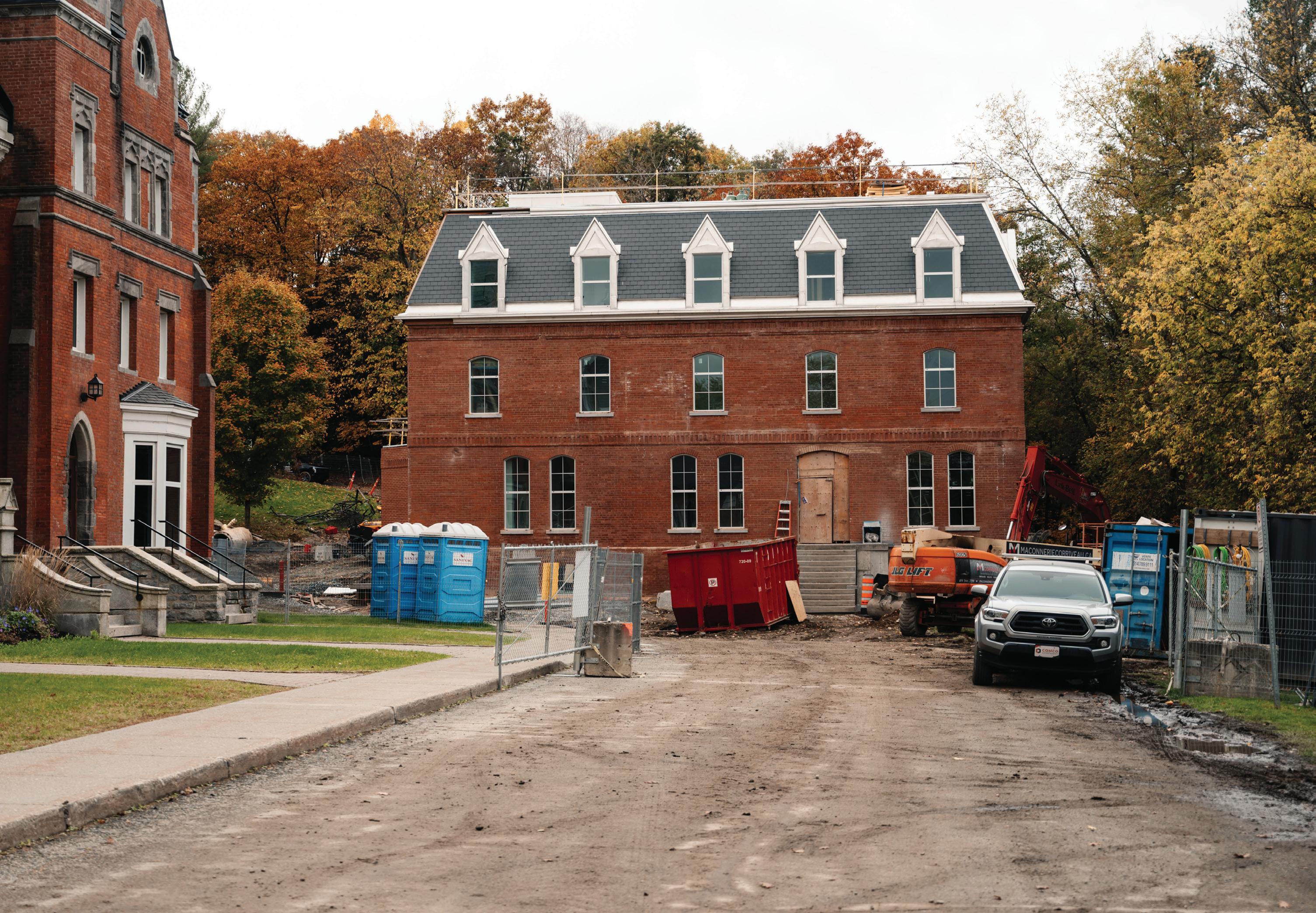
Student run since 1944 October 15,
BU charity fashion show holds Rubber Ducky Golf Tournament BU golf on a roll The truth about the upcoming humanities week
Student mobilization is
Kwigw8mna: Building a legacy of resilience



Student run since 1944 October 15,
BU charity fashion show holds Rubber Ducky Golf Tournament BU golf on a roll The truth about the upcoming humanities week
Student mobilization is
Kwigw8mna: Building a legacy of resilience

By Megane Masson - Contributor
As Truth and
Reconciliation
Week drew to a close, Bishop’s University highlighted the national holiday with various activities led by the Indigenous Student Support Centre (ISSC). The week also provided an opportunity to highlight the ongoing construction of Kwigw8mna, formerly known as Divinity House, which is being transformed into a new centre for the Indigenous community at Bishop’s. The centre and an accompanying documentary both carry deep significance, helping the Indigenous community reconnect with a piece of land that was historically theirs.
The Kwigw8mna House is designed to be a home away from home, as noted by Shawna Chatterton-Jerome, coordinator of Indigenous student support services. Kwigw8mna will feature a communal kitchen, a library, gathering spaces for Indigenous peoples and quiet study rooms in the basement. The upper floor will house an apartment-

style section where relatives and guest speakers can stay for short periods, offering Indigenous students a gathering place free from external pressures— a space where they can thrive to be their authentic selves.
The building is not just under construction; it represents the creation of a community that has long needed attention and care. The individuals behind this project had to advocate for their vision and communicate their needs clearly. Their voices had to be heard for this project to come to life. The building itself embodies the voices of Indigenous peoples, advocating for themselves after generations of being silenced and marginalised. Now, they have a space where they can speak as loudly and clearly as ever before.
While Shawna Chattetron-Jerome acknowledged a few challenges along the way, she emphasised that the
Read more on page 12
By Julie-Ann Vollant-WhittemoreContributor
The National Week of Truth and Reconciliation took place from Sept. 20 to Oct. 4, 2024 at Bishop’s University, in collaboration with Champlain College, Estrie Higher Education, Cégep de Sherbrooke, and Université de Sherbrooke. This two-week period focused on educating and raising awareness around the legacy of Residential Schools and fostering reconciliation between Indigenous and nonIndigenous communities.
At the heart of these events was a commitment to confront Canada’s historical mistreatment of Indigenous peoples, particularly through the Indian Residential School system, which operated for over a century. This system forcibly removed Indigenous children from their families to attend state-funded religious schools to erase Indigenous cultures, languages, and

identities, leaving lasting trauma across generations.
Why Truth and Reconciliation Matters
Truth and Reconciliation Week offers an opportunity for both Indigenous and non-Indigenous people to reflect on this dark chapter in Canada’s history. It’s about acknowledging the past and understanding the ongoing impacts on Indigenous communities today. The week’s events at Bishop’s University emphasized the significance of reconciliation—a process aimed at repairing harm caused by colonial policies and creating a future rooted in mutual respect.
Shawna Jerome, a support worker at the Indigenous Student Support Center (ISSC), stressed the importance of participation:
“This history belongs to all of us. It is
Read more on page 3
By Chelsea SheridanContributors
On Oct. 6, the Bishop’s University Charity Fashion Show hosted its annual Rubber Ducky Golf Tournament, an event beloved by many Bishop’s students. Last year, the organization set a fundraising record by raising $28,000, which went directly to the Dixville Foundation. Following the disruptions caused by COVID-19, the fashion show made a triumphant return with the theme “Embrace,” which reignited excitement and enthusiasm among participants. This year, the theme built on that momentum with “Inspire”, encouraging individuals to step out of their comfort zones and contribute to a cause larger than themselves. All funds raised this year will support the Lennoxville and District Community Aid, a local organization in the Lennoxville
community. This organization helps seniors 65+, those with a geriatric profile, and convalescents to continue living at home. Through services like Meals on Wheels, transport assistance, friendly visits, and caregiver support, they improve quality of life and foster community connections. Serving Lennoxville, Waterville, North Hatley, and Canton de Hatley, they also offer exercise and fall prevention programs, foot care, and technological assistance.
Despite fewer participants than last year’s Rubber Ducky event, the day was a massive success. Six teams of four to six individuals showed up with enthusiasm, golfing their way around Lennoxville. Each hole was located at an iconic spot in town, and teams solved clues to uncover the location of the next hole. Every team rocked a different, funky theme, including PJ party, wigs, jerseys, construction uniforms, and onesies. Instead of golf balls, participants must use rubber duckies and whack them at targets, giving a fun and light-hearted twist to the

traditional game. The Popular Loners, the tournament winner, commented on the event: “All of us were so excited that we had the chance to be a part of the rubber ducky tournament. The event was full of good vibes and fun. We are looking forward to what’s next this year!”
Head coordinator Sasha KardosMachado shared that “Rubber Ducky
By Olivia Woods - Contributor
Hurricanes desecrate the southeastUNITED STATES
Florida is in a state of emergency after a devastating series of hurricanes. Hurricane Helene impacted six different states on Sept. 26. Categorised as a category four hurricane (on a scale of five), it is the deadliest hurricane to hit the United States since Hurricane Katrina—hurricanes with such strength lead to storm surges, tornadoes and unimaginable damage to communities. As northern Florida and its neighbouring states began to mobilise to start to rebuild these communities and support those who have lost loved ones, central Florida prepared for Hurricane Milton. Hurricane Milton hit late on Oct. 9. Originally predicted to be a level five storm, the level three storm tore through the Tampa Bay Area. The White House has deployed more than 8,000 personnel across the southeast to aid in recovery efforts. Although the southern state is not new to tropical storms, with the current climate crisis, the frequency and strength of these disasters continue to grow. Many citizens are turning to the current presidential candidates for what’s next.
The provincial government of Assam recently announced that the one-horned rhino

population is at an all-time high. The eastern Indian province is home to the iconic onehorned rhino. Kaziranga, the province’s largest national park which spans over 42 hectares and is famously known as home to the onehorned rhino. Since 2008 a program known as the Indian Rhino Vision 2020, has been working on relocating various rhinos from around the country to Kaziranga due to high levels of poaching. With an estimated Rhino population of 600 in the 1960s Assam now has over 3,000 one-horned rhinos and has no plans of stopping to support this project. Educational programs in local schools, watchtower camps
was a huge success! It was so fun to see everyone dressed up and enjoying their Sunday Funday!” The event was a success in large part because of the volunteers, participants, and sponsors who made it all possible. Their support upholds the beloved tradition of Rubber Ducky Golf, bringing the community together while making a difference for local charities. Here’s to many more years of fun and fundraising!
for park guards and introducing patrol roads throughout the park are in the next phases of the program. Poaching has been a target of the provincial government with rates dropping 86 per cent since 2016, however there is still a serious threat as rhinos are targeted for their horns. “The one-horned rhino is synonymous with the identity of Assam and is the pride of our biodiversity” the Assam Chief Minister Himanta Biswa Sarma announced on World Rhino Day. The current government has made it a top priority to protect the rhinos and strive to eliminate poaching.
On Thursday, Oct. 10, Minister JeanFrançois Roberge presented Bill 74 “ An Act Mainly to Improve the Regulatory Scheme Governing International Students.”
The bill aims to limit the number of international students who can study in Quebec and which institution they attend at the discretion of the provincial government. This comes after reports that private universities are being used to obtain citizenship
The exact numbers of the bill are vague. It has not been said what the cap will be, but the numbers will go down. Roberge plans for the Bill to be adopted by September 2025. The Minister of Higher Education Pascale Déry assured the press that “We’re not targeting English institutions, everyone is targeted or everyone should be concerned”.
Jillian French, News Editor » thecampus.news@gmail.com
continued from page 1
crucial to engage in the activities during the National Week of Truth and Reconciliation. It’s our responsibility to learn and unlearn.
Moving forward requires building positive relationships with Indigenous peoples and communities. This is not solely for Indigenous peoples; nonIndigenous peoples must also take the initiative in educating themselves and others.”
The History Behind the Orange Shirt
The Orange Shirt has become a national symbol of remembrance through the story of Phyllis (Jack) Webstad. In 1973, Phyllis, a six-year-old Indigenous girl, was sent to a Residential School. Her grandmother gifted her a new orange shirt, which was taken away upon her arrival. The shirt symbolizes how Indigenous children were stripped of their identity, language, and culture.
Orange Shirt Day, observed on Sept. 30 each year, honors Phyllis and the thousands of Indigenous children who suffered under the Residential School system. It’s a day of remembrance and a call to action, reminding Canadians that “Every Child Matters.” Wearing orange on this day shows support for survivors and acknowledges the lasting impact of Residential Schools.
As an Innu woman and thirdgeneration survivor, I wear orange with
pride. I am a 2nd-year Bishop’s University student studying pre-clinical psychology and a minor in Indigenous studies. My grandparents survived residential schools, and my father attended Indian day schools. Growing up was rough, full of trauma that still lingers. That’s why I left my community to pursue higher education—to help heal the next generations by bringing knowledge back and being part of a system that once tried to hurt us, but now supports me in building my sense of self. Wearing orange is a powerful statement for me because we are fighting for change so future generations will be safer and prouder of who they are.
Events at Bishop’s University
The events at Bishop’s University during Truth and Reconciliation Week were diverse and engaging, designed to provide various entry points for learning. From the Indigenous Peoples Atlas of Canada Giant Floor Map to discussions about treaties and land disputes, the programming helped participants deepen their understanding of Indigenous history and contemporary issues.
Vicky Boldo, an ISSC staff member and advocate for Indigenous rights, reflected on the significance of the Truth and Reconciliation process:
“After years of reflection and healing, I feel as though intergenerational survivors of Indian Residential Schools and Day Schools seek justice. Some felt strongly that this was a missing
component from the original report. The testimonies confirmed the stories that many had carried for decades. The work is far from done! We are not in post-TRC times. Apart from pulling out your orange shirt once a year—what will you do to uphold justice for Indigenous rights to land, language, education, self-determination, housing, and clean water?”
Champlain College: A Student’s Perspective
The focus of the week extended to collaborators like Champlain College. During the Every Child Matters Walk at Parc Jacques-Cartier, firstyear psychology student Ieriwasetha Dailleboust shared her perspective:
“Kwe, I learned traditional teachings on my land, something I took for granted. Being here made me realize that I carry the knowledge passed down to me.”
Building an Educational Future Truth and Reconciliation Week at Bishop’s University is not just a time for reflection but also for action. We introduced a new educational tool focusing on Indigenous discrimination, biases, and how non-Indigenous people can become better allies. This project, which took over a year to develop, includes videos, illustrations, and discussion scenarios aimed at building understanding and empathy. I contributed illustrations, including a turtle logo symbolizing Indigenous connections to the land.
Additionally, I spoke on a panel at Champlain College, engaging with current students and sharing my experiences as a former Champlain student and current Bishop’s University student. This moment allowed me to connect with the next generation and encourage them to embrace reconciliation.
The Call to Learn More
Truth and Reconciliation is not just a yearly event, but an ongoing process. The goal is to encourage everyone to learn about Canada’s Indigenous peoples and their histories. Wearing an orange shirt or attending a walk is a start, but true reconciliation requires continuous effort. The events at Bishop’s University are just one chapter in a much larger story, one that we all need to engage with to create lasting change.

Angus Whyte - Associate Editor
Since 2021, Trudeau’s Liberal government has held a minority position in the House of Commons, supported by a confidence and supply agreement with the NDP. The agreement, which was struck in 2022 and scheduled to run until 2025, was cut short by NDP leader Jagmeet Singh in a public announcement last month. But what is a confidence and supply agreement? How might this affect the political landscape as we head towards a looming federal election?
In Canadian politics, minority governments have a harder time passing legislation compared to majority
Tgovernments, because they depend on votes outside of their party to produce majority approval for a proposed bill. As a result, bills proposed by a minority government often cater to the interests of oppositional parties or risk being shot down in the House. This is where confidence and supply agreements enter: simply put, these agreements form a coalition between the minority government and a major third party with the intention of teaming up against the official opposition.
In the case of the Liberal-NDP coalition, the Liberals (holding 160 seats) recruited the NDP (holding 24 seats) to surpass the 170 seats needed for a majority. This relationship was mutually beneficial: the Liberals ensured the continuity of their government; the NDP advanced their agenda by influencing the Liberal
mandate. However, recent disagreement between the Liberal and NDP parties concerning corporate interest has resulted in the termination of the confidence and supply agreement. Without the support of the NDP, the Liberals may lack the votes to survive a vote of non-confidence, ushering in a federal election sooner than anticipated. With Conservatives leading by 20 per cent in projected polls in a recent publication, a federal election would almost certainly lead to a Conservative government.
The election cycle also impacts government spending. Towards the end of the election cycle, governments often choose to increase spending to buy support in the upcoming election. In and of themselves, shifts in government can also greatly alter the federal budget. As a public university, Bishop’s should take
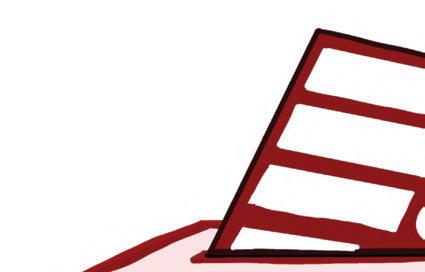




Graphic courtesy of Payton Lanegevin
a keen interest in the upcoming election, and be aware of how the termination of the Liberal-NDP confidence and supply agreement may bring about an election sooner than expected.
he Campus acknowledges that the land on which we operate is stolen land, the traditional territory of the Abenaki people. We live, learn, work, and play on this land, home to Indigenous peoples still living. Canada was founded through colonization, a system rooted in oppression and the abuse of power over others, continuing to affect First Nations, Inuit, and Métis communities today. As a student newspaper, The Campus has a responsibility to highlight truth. We are committed to prioritizing underrepresented voices in our community and proactively highlighting Indigenous peoples’ histories and ongoing realities, including their resilience and achievements. We recognize our work plays a role in shaping public perceptions, being able to call-out injustice but also call-in action. We emphasize that we must go beyond a land acknowledgement, which is only one step towards reconciliation. It is the stories in our paper – told with respect, accuracy, and integrity – and the respect and humility we show to the land and others that is more important than what is written in a land acknowledgement. Actionable steps to go beyond a land acknowledgement include educating ourselves and others, and supporting Indigenous traditions, movements, and businesses. —The Campus Team
By Halle Brindley - Opinions Editor
You’re probably familiar with names like Chappel Roan, Sabrina Carpenter and Olivia Rodrigo. Forget the ‘big three,’ I’m talking about the ‘Holy Trinity’ of female artists who are taking the reins of the music industry. Aside from their talented voices, what distinguishes them from other pop artists? Why these three?
Their lyrics encompass another stage of the love cycle: spite, anger, guilt – the honest truth.
In 2017, Taylor Swift released her album “reputation,” an album composed of spiteful, revenge-like songs that were an honest depiction of her feelings at the time. Unfortunately, the album did poorly upon its release. For me, I literally thought Tay-Tay had lost herself and was going into rap. Sad day for a Swiftie! With the album recently spiking in sales, she proved to be ahead of her time. By 2021, Olivia Rodrigo’s successful first album, “SOUR,” performed so well that it was the precedent for what was to come: albums consisting of the reality of feelings, the good AND the bad. There is no longer a market just for the perfect “Love Story,” but rather a market for relatability.
Carpenter’s song “Lie To Girls” implies that if a girl likes you enough, she will lie to herself, romanticize a relationship, overlooking the bad, a seemingly shameful act that isn’t talked about aloud. Arguably, songs like this could be eye-opening for someone who is conflicted in a relationship, serving as reminders that they deserve better.
I’ll be the first to admit that I have romanticized someone because I had such a big crush on them, when in reality, we couldn’t have been further from being compatible. To admit to that in high school? Oh, absolutely not! In no Universe would that have EVER happened. Thank you, next!
Even worse, I was willing to become the perfect “all-american” girl who “[doesn’t] get angry when [she’s] pissed/ ... the eternal optimist/... [is] grateful all the time/ [is] sexy and kind/ ... pretty when [she] cries,” you know that one (Rodrigo, “all-american b****”)? Well turns out, the man of the hour “did have a type and it [wasn’t] me” (Carpenter, “opposite”). Surely, “my friends [were] calling me a loser/ ‘Cause I [was] still hanging around,” but the movies and the music felt made me feel like I was going to have a different situation (Roan, “Casual”). Everything in the media was about hope and love, so was it so wrong to think that my reality would be just that?
By Ilona Plat - Contributor
The deadlines, the different numbers of references and, let’s not forget, the different motivation letters are all significant parts of the master’s application process. Additionally, senior year is usually synonymous with a loaded schedule without mentioning the potential extracurriculars you added to your workload to increase your competitiveness. Thus, application for a master’s can seem very daunting. As scary as it can be, this article is here to support you in this crazy journey.
Being in the current process of applying to a psychology master’s, I reassure you that I, too, feel that I will not be able to do it all. However, my friends who went through the same thing last year gave me a great piece of advice: treat applications as a course. That means preparing yourself to do it for a couple of hours during the week, ideally on a fixed day. Giving yourself “homework” is the best way to do it.
Organization, in general, is going to be your best friend. Understandably, being organized is something only some people have, but some software can help. Excel, for example, is an excellent way for you

Eventually, I did change my perspective on this, which I will certainly credit with the help of Miss Rodrigo. And so, where am I now? Oh baby, I’m that Espresso! I’ve been that “me espresso,” no doubt! I mean, my boyfriend probably got so into coffee because of me. He “can’t sleep/...[he’s] thinkin’ ‘bout me every night,” because, well “that’s that me, espresso” (Carpenter, “Espresso”).
Do you see what I mean, now? The pop singers have created a twist on the conventional love song, they have put into lyrics the things that we wouldn’t even verbalize ourselves. As if it were a group choir, me and 20,000 other people sang our hearts out the other night, all united by that 5-foot blondie: Sabrina Carpenter. SC since ‘03! (I was born in 2002, but it’s still a good line, let it go!)
to set out all the different requirements by school and keep track of where you are at. Planners or calendar software can also help you keep track of what you must do next and give yourself fixed objectives to keep progressing. Another trick that seems small but can go a long way is to create one file per school on your computer to not mix up all your different application materials. It’s all about finding the systems that work best for you!
Completing all the different requirements alone can be very challenging, mainly if you aim for competitive programs and want to stand out. This is why reaching out to the career and transition services here at Bishop’s is one of the best things you can do. They offer help with writing your resume, cover letter, and even LinkedIn! They also provide a service for graduate school support, which is very useful. I have used these services already, and I strongly recommend them. Asking your friends for their opinion on your work helps, but having the opinion of professionals is what will make your application the best possible.
The most important thing, however, is to remind yourself of the long-term goal. In facing the stress from preparing for your application and meeting the deadlines, it’s
easy to get unmotivated and forget the reason why you want to pursue a master’s, or any other post-undergraduate studies.
For me, it’s the only way to my dream job, which I remind myself of every time. Keep your long-term goal in mind, it will inspire you to keep going.
While organization, motivation, and reaching out to career and transition services are the main parts of applying
for a master’s, it’s crucial not to neglect your well-being and sanity. Remember, taking time for yourself is not a luxury, it’s a necessity. It goes a long way in helping your productivity in the long run. Remind yourself, too, that many other students are probably going through the same stress and will get admitted! So do not worry; keep working on your applications slowly, and it will all be okay!

Halle Brindley, Opinions Editor » thecampus.opinions@gmail.com
By Virginia Rufina MarquezPacheco - Contributor
As current events and policies develop in our world, students at all levels are seeing decisions being made about their resources and their futures without their voices being heard. Students must realize that they possess enormous power to influence university and government policy outside of the typical parliamentarian means. That power, if mobilized effectively, can send shock waves that will reverberate throughout our society.
In the past, student bodies have successfully mobilized to create tangible change in their society. A classic example is the student strikes protesting the Vietnam War that gripped the United States and culminated in May 1970. Thousands of students from across the country organized walkouts, teach-ins, and other forms of peaceful protests which impacted the narrative around the war. In the 1980s, another wave of protests emerged in North American and European universities to protest against the apartheid regime in South Africa. These student protests demanded that their institutions divest from any corporations
complicit with the apartheid regime. Most mobilization efforts were successful in forcing their institutions to divest, which in turn brought pressure on governments to adopt similar measures, eventually leading to the downfall of that system.
Many examples of successful student mobilizations exist closer to home and closer in time. In 2012, after the government of Québec announced an outrageous hike in tuition, thousands of students took to the streets for six months, paralyzing not only the education system but also larger parts of society by extension. These strikes, called the Maple Spring, were successful in forcing the government to roll back on their proposed tuition hikes. The then-premier Jean Charest lost the next election. Additionally, last year, when the provincial government announced a hike in tuition for international students, Bishop’s students protested and campaigned. The result: Bishop’s was exempt from the tuition hikes.
Today, we see many things unfolding that are harming people both at home and abroad. The government is complicit in a genocide carried out against Palestinians by the Israeli state, with the complicity of several Canadian universities. At the

same time, the provincial government of Legault announced a slash in spending for CÉGEPS and universities, stunting their abilities to provide much-needed infrastructure renovation. We cannot forget to mention the lack of investment in healthcare, education and social services. On top of this, there is still the continued destruction of the planet’s environment
and ecosystems. All of these decisions negatively affect students both here and abroad, but students have power in numbers. We can unite to paralyze a system that is no longer serving us adequately until they do their duty to represent our will. We should not be afraid to use that strength by collectively mobilizing for a cause. After all, is it not our right to peacefully protest?
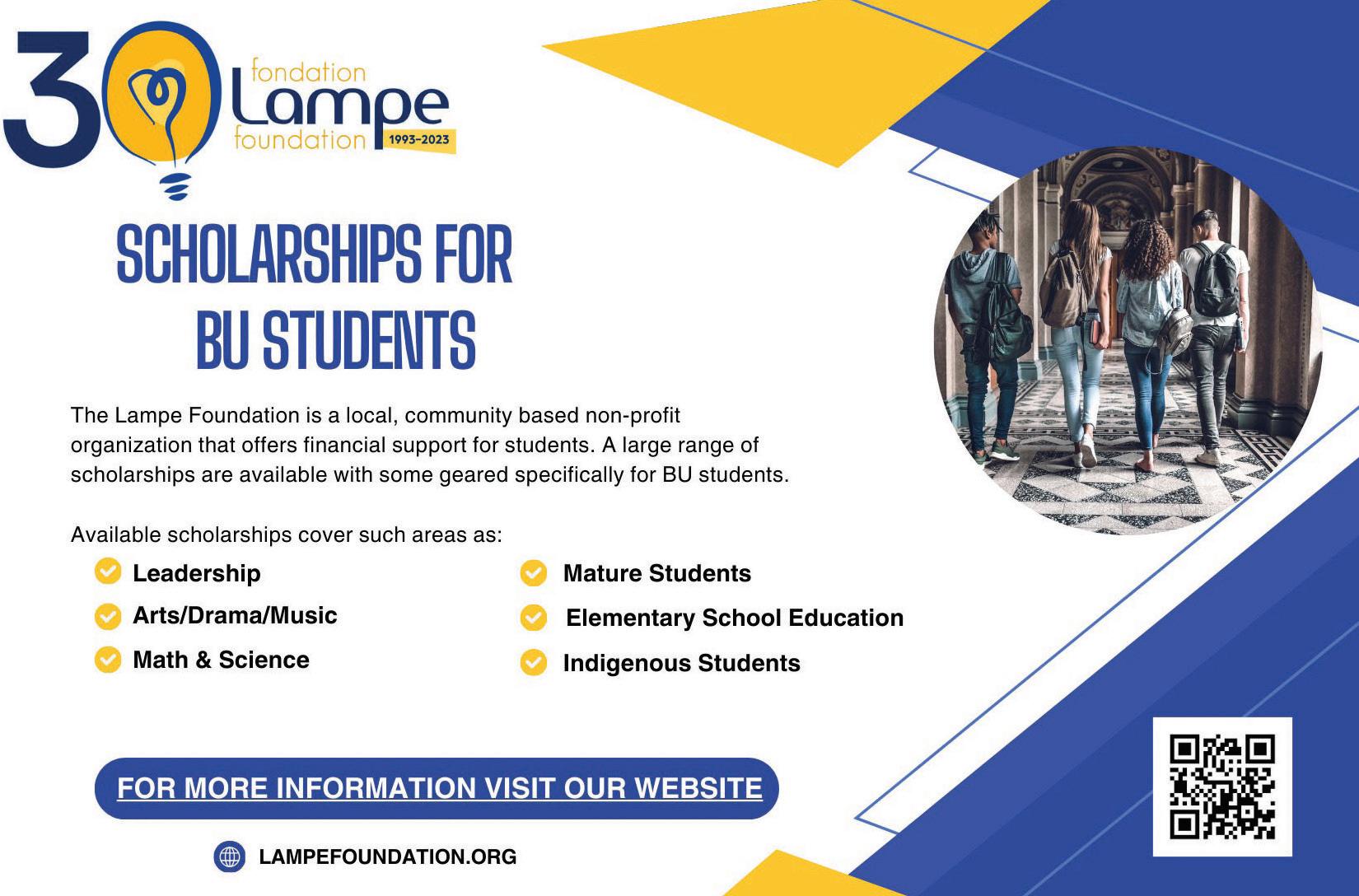
Owen Kitzan, Sports Editor »
By Owen Kitzan Sports Editor
With fall bringing colder and less favorable outdoor conditions, the 2024 golf season is beginning to come to a close. That being said, those dedicated to the sport can still be found sharpening their game and continuing to strive to be better. BU golf has consistently been showing progress over the last few years, culminating in the exciting program they are today.
The Gaiters kicked off the season on their home course, Milby Golf Club, for the first RSEQ tournament of the year. The men would come in first place finishing plus eight, ten strokes ahead of second place Laval, who finished plus 18. Trailing closely behind would be UdeM, who came in
third at plus 21. On the women’s side, they would shoot a plus 108, good enough for third place behind Laval at a plus 49 and Sherbrooke at a plus 87.
The second RSEQ tournament of the year took place in Lévis, Quebec. The Gaiters men would finish third this time around, shooting a plus 81 with Laval and Montreal finishing first and second with scores of plus 39 and 55 respectively. Laval would also win on the women’s side of things with a score of plus 63 while Bishops would come in second shooting a plus 115, 37 strokes ahead of thirdplace Sherbrooke.
The next RSEQ event would be the finals held at the Gatineau Golf Club in Aylmer Quebec. Both the men’s and women’s sides looked to compete for championships, with the mens team having won the year
before to snap a twenty-year Laval streak. Sadly, Bishops would come in second place in both the men’s and women’s sides, with Laval Golf taking home both of them. The men’s team would finish 18 strokes behind Laval finishing with an overall score of 26 strokes over par. Meanwhile, Laval’s women’s team would run away with the competition, shooting a score of 43 strokes over par, 51 strokes better than Bishops who shot a combined plus 94.
Despite not being the finish they had hoped for on the year, Bishop’s golf continues to prove they are a powerhouse in RSEQ golf. They have grown exponentially as a program in the past few years and look to continue that trend into the upcoming years. With Samuel Breton-Gagnon recently tying the Milby course record by shooting nine strokes under for a score of 64, the team continues
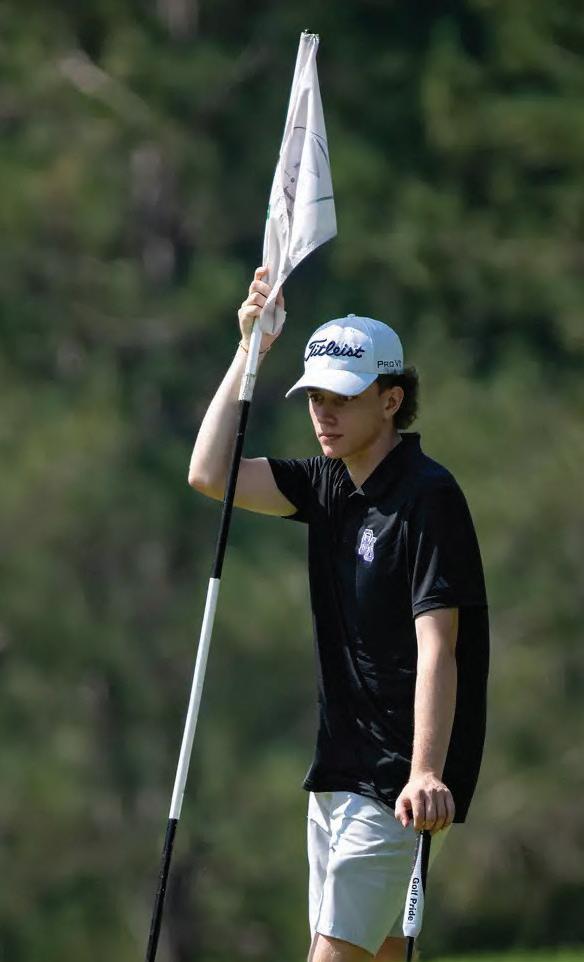
By Leighton GeraghtyContributor
Jane and Eric Molson arena, home of the Bishop’s Gaiters and the BU Men’s hockey team, recently saw its first university game of the season. The BU men’s hockey team kicked their season off at home, facing off with conference rival, Massachusetts Maritime Academy. Throughout training camp, the team saw new players joining the squad. Eight new faces have been added to the roster alongside a returning player from two years ago, Luke Thorne. After a devastating defeat in Nationals last year, the team has shifted their focus to bouncing back and cementing their names among the best in the AAU.
The home opener was Saturday, Oct. 5. As both teams took the ice for warmups, the atmosphere was bumping with a white-out theme filling the seats. The puck dropped at 2:30 p.m. as the long-awaited start finally came to play. Bishops started strong, as freshman defenceman Nathan Gagnon scored his first collegiate goal 59 seconds into the game to give BU a 1-0 lead over MMA. Bishops continued to dominate, treating their home crowd to a 7-0 win to start the season off. Transfer goaltender Antimmes Leudiere recorded his first shutout of Bishop’s career. When asked about the energy from the crowd captain Joseph Aubert responded, “It was unbelievable! Having everyone behind us, especially for our first game, gave us the extra push we needed to come away
victorious. It really felt like we were playing with an extra man on the ice.”
He said, “Having that level of support behind us made a huge difference and we are excited to keep building on this momentum all season.”
Both teams were back in action the following day for an 11 a.m. puck drop. Bishop’s came out fast as they knew MMA was playing their third game in three days. The match
played out much like the first game: BU dominated, utilizing their speed to their advantage. With a new lineup and some injuries from the first game, BU was able to showcase their depth. Luke Thorne, returning from Junior A in the Maritimes, recorded a hat trick in the game. He finished the weekend off with eight points. The game finished 6-1 in favor of Bishop’s as they would move to the top of the conference standings now at 2-0 on the season.
Now, the Men’s team shifts their focus to their next couple of games. Heading on the road, they will face one of their hardest challenges yet, playing RSEQ division 2 powerhouse, the Concordia Stingers over Thanksgiving weekend. They will be back in league play the following weekend as they travel to Massachusetts to play both Stonehill and Massachusetts Maritime Academy.

By Christina Lépine - Staff Writer
This semester, the tennis club coleads, Rosane Delorme and Hugh Englehart, introduced a new sport to students: pickleball. On Mondays, from 8 to 10 p.m., students can play Pickleball in Denver Gym. Pickleball nights are open to anyone who desires to learn how to play this sport, as well as advanced players.
Pickleball, over the past year, has been on the rise, becoming more popular in Canada and the United States. It is a lower-impact sport, compared to tennis, easy-to-grab and semi-portable

as it requires minimal equipment to play. Nets, smaller and lower on the court than tennis nets, are often portable so can be set up on any court following a set of lines. This makes it easy for anyone coming to pickleball nights to set nets around Denver gym creating multiple courts for people to play. This sport can be played in single or double, similar to tennis, with a pickleball paddle or racket and a plastic ball. The Sports Complex offers this equipment for free when presented with a student ID at the front desk, making it accessible for all students to play.
Delorme mentions she and her co-lead had the idea to launch this initiative to diversify the offerings of their club as she started playing pickleball two summers ago and fell in love with the sport. She mentions “Pickleball is a social sport, allowing university students to take a break from their studying to be active and socialize”. The club has noticed an impressive turnout to their Monday events as Denver Gym was packed with students wanting to learn how to play and meet people. The club co-leads are “very content with the turnout of their event. The courts are always full, and people are enjoying themselves and socializing with friends all while breaking a sweat”. Englehart and Delorme have received positive feedback from beginners who have enjoyed trying this new sport and advanced players, thankful for this opportunity to play.
In upcoming semesters, the club is hoping to add another night of indoor pickleball to their schedule.

The co-leads are hoping to offer a minipickleball tournament this year. They have also applied for funding through the Gaiter Grants Committee, managed by the Students Representative Council for their clubs, to acquire rackets and portable nets to offer new locations to play,
either indoors or outdoors, in upcoming semesters.
Should you want more information on Pickleball Mondays or to join in on this sport, consult the club’s Instagram account for updates on their scheduled activities offered every week.
By Dylan Monico - Contributor
On Oct. 5, 2024, the Bishop’s Gaiters traveled to Antigonish to face the St. FX X-Men with the hopes of returning with the coveted Bigg Bowl. A trophy they had not held since 2019. Also on the line and carrying maybe a bit more of a weight on the Gaiters shoulders was a chance to clinch 1st place. Almost a replica of last year’s Bigg Bowl, this game would
need multiple overtimes to find a winner. It would be the Gaiter’s own O’shae Ho-Sang (2nd year, Lasalle, QC) who would deliver the final blow on a six-yard run in double overtime to seal the 42-37 victory.
The Gaiters offense with 3rd year southpaw Justin Quirion (Saint-Georges, QC) at the helm completed a phenomenal comeback drive to send the game to overtime. The 13-play 75-yard drive was capped off
by a Marco Briones (5th year, Monterrey, Mexico) 18-yard catch and run to make it 27-29 with just six seconds left in the game. Quirion would connect again with Briones on the two-point conversion tying the game and sending it into overtime. Quirion was impressive, throwing for 354 yards and three touchdowns. This was Quirions 3rd game of the season throwing for more than 350 yards and he currently sits 4th in the entire country in passing yards with 1884 yards and tied for

4th with 12 Touchdown passes.
Ho-Sang was lights out for the Gaiters once again, rushing for 145 yards and finding paydirt twice. O’shae has been producing all season long he currently has 598 rushing yards and 8 rushing touchdowns which is tied for the most in the country. His ten total touchdowns are the most in the nation and he currently is 2nd in the entire nation in all-purpose yards with 1226. On the defensive side of the ball for the Gaiter’s 2nd year defensive back, Mathieu Déry (Lac-Beauport, QC) was a big part of the game tallying 7.5 tackles and breaking up three passes. Déry has 9 breakups on the campaign making him 1st in Usports. Francois Richer (2nd year, Boucherville, QC) was also a contributor to the Gaiter’s defense registering three tackles and a sack.
The win brings the Gaiters to a solid 6-0 and as mentioned before they have clinched 1st place in the Atlantic conference and will have home-field advantage for the playoffs. The 5th-ranked Gaiters will travel to Wolfville to face the Acadia Axemen on Oct. 19 and will close out the regular season on Oct. 25, when they host the Mounties of Mount Allison.
Katlyn Stoneburner, Features Editor » thecampus.features@gmail.com
By Grace JohnstonContributor
If you find yourself looking for Joen Blumer, you should start your search out in nature. Blumer spent most of his childhood in Vancouver, which he remembers as a blur of one outdoor adventure after another. He fondly remembers hiking through mountain ranges and sleeping in tents, attributing his love of nature to this outdoorsy upbringing. He has since moved to Quebec and is in his third year at Bishop’s.
Blumer has slowly tailored his post-secondary education to his love of science and the outdoors. He entered CEGEP in Social Sciences but was inspired to switch to Sciences after a game-changing biology class. He later applied to B.U. for a B.A. Biology Major but quickly transferred to the BSc Program, further leaning into the sciences. Now in his third year, Blumer’s BSc has branched into a Biodiversity and Ecology Concentration, where his true passions
lie.
After three years of classroom learning and university labs, Blumer was itching for hands-on fieldwork. Under Dr. Sarathi Weraduwage’s guidance and with the benevolent help of the B.E.S.T. Project Fund, Blumer secured an internship at the Institut de Recherche en Biologie Végétale (IRBV). Blumer was initially intrigued by Montreal’s infamous Botanical Gardens that neighbour the IRBV. Throughout the summer he mapped and analysed data on primordia growth on Arabidopsis T. meristems, while occasionally sneaking off to explore the heavenly gardens. He was supervised by biophysicist Anne-Lise Routier, head of the lab and research project. Blumer’s role was mainly geared towards analysis and not necessarily the fieldwork and fresh air he was craving, however, it was still an invaluable insight into reallife biological research. He described that in university, you follow a procedural recipe book of steps, but in a real research scenario, you need to problem-solve and think on your feet.
With the IRBV, Blumer was also privy to weekly PhD research presentations. He observed while his superiors critiqued students on minute details, developing his critical eye and providing him with an instruction manual for the ‘Dos and Don’ts of research. This breadth of exposure to different projects gave Blumer a small taste of academia and prompted him to imagine what his own research could entail.
Back in Lennoxville for his supposed final year of undergrad, he is now considering BU’s Honours in Biology program, followed by a Master’s Degree. However, he is also a wildlife enthusiast and his academic goals will certainly be interspersed with ‘gap years’ of travel and adventure. Blumer has an affinity for cheetahs; he finds them captivating and is saddened by their endangered status in Africa. He dreams of venturing into Big Cat conservation and wildlife photography, to be close to and protect these wild beasts. In decades to come, he wants to look back on his career and take pride in the environments he conserved and endangered species he protected from
extinction.
Regardless of his path, Blumer is grateful for the generous support of the B.E.S.T. Project for “funding students’ dreams” (Blumer). He is excited to take the reins on a research project and launch himself into data collection and fieldwork - which, in his case, may be in an actual field.



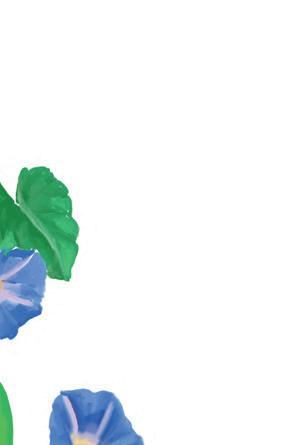

By Lauren Root – Staff Writer
When Dr. Linda Morra first pressed record during the pandemic, she had no idea her podcast, “Getting Lit with Linda,” would soon gain an international following—and make her a finalist for a prestigious Women in Podcasting award. This international honour is just one of many major accomplishments for Dr. Morra, who began her podcast, “Getting Lit with Linda” in 2020. Originally meant as a tool for her students, the international outreach of Dr. Morra’s podcast has been extremely impressive.
The Women in Podcasting award that Dr. Linda Morra is currently a finalist for means that her podcast, “Getting Lit with Linda” is among the top three podcasts in the world in terms of education. Prior to this honour, when the awards for her podcast began, Dr. Morra said: “it’s a sharp reminder that you’re responsible to and engaged with a much larger audience” and that she was no longer podcasting in her closet. While her podcast has grown to heights she never imagined, she now feels more confident in herself, and uses these awards as a reminder that she is accountable to her audience.
“Getting Lit with Linda” was an idea born in 2020, after Dr. Morra read a draft of 25 Things I Wish I Knew Before I Started My Podcast, written

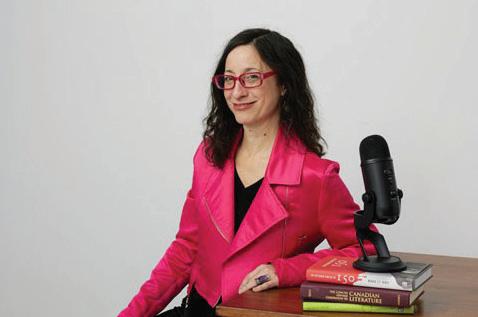
by her good friend Marco Timpano. During this time, Dr. Morra was grieving from the passing of her parents and wanted to start a podcast to reach out to her students and family during the pandemic. Her podcast served as a way to work through literature and to process what had happened in her personal life. Literature helped her comprehend the emotions of her grief and relate them back to various texts. This idea is beneficial for all listeners, since the podcast touches upon general subjects, such as forgiveness, and how it is shown in literature. When her podcast began to reach more people, Dr. Morra realised this medium was a fantastic way of connecting with
people around the world. As Dr. Morra states in her podcast: “Just doesn’t bear upon literature, it bears upon life.”
Dr. Morra’s podcasts have primarily benefited English students since she uses them to speak about the Canadian and Indigenous literature that she teaches. She specialises in these topics, so podcasting on this subject allows her to instruct people around the world, extending her outreach and exposing people to literature they may not know much about. The latest step in Dr. Morra’s extraordinary journey will happen by the end of October, when the Women in Podcasting winners will be named.
Katlyn Stoneburner, Features Editor » thecampus.features@gmail.com
By Virginia Rufina Marquez Pacheco - Contributor
An epic poem is a lengthy narrative poem which recounts the great deeds of extraordinary individuals, typically of mythical figures like heroes and gods. Epic poetry is one of the oldest forms of literature that survives to this day. Famously, the Epic of Gilgamesh is
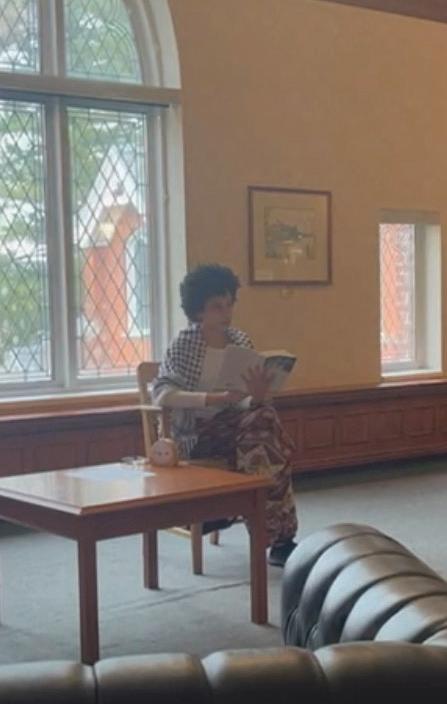
the oldest piece of literature that we know of, found on a cuneiform tablet from ancient Mesopotamia. Other epic poems from the Graeco-Roman tradition include the Iliad and the Odyssey by Homer and the Aeneid by the Roman author Virgil.
A key aspect of epic poetry is that it was meant to be recited or sung, not read off the pages of a book, just like much of modern poetry. For example, it is thought that the writing forms of Homer’s epic poems that came down to us might be a compilation of many tales that would have been sung in the hall of ancient Greece. Thus, to honour this oral tradition, on Friday September 27, the Classical Studies Department hosted its annual reading of an epic poem.
Though in the past readings of the other epic poems were organized, this year, the department chose to conduct a reading of Homer’s Odyssey. This epic poem recounts the story of the Greek hero Odysseus as he attempts to journey home after the ten yearlong war against Troy. Encountering lotus-eaters, the cyclops Polyphemus, the infamous Circe, gods and other monsters, Odysseus’ journey home to his wife Penelope and son Telemachus takes him ten years. This tale is undoubtedly one to captivate audiences.
This enterprise was organised by Dr Jenn Cianca, Chair of the Classical Studies Department and it involved the efforts of several volunteers. The epic reading marathon started at

6:30am in the Cleghorn room with Dr Jenn Cianca reading the first book.
Each volunteer read for shifts of thirty minutes, each one taking over from the last reader with no break in between.
The reading ended around 4:30pm.
While some students remained during the entirety of the marathon, others dropped in and out.
The reading was followed by a wine and cheese gathering that was open to all. Students, faculty and staff were able to socialize over refreshments. This event was a wonderful occasion to socialize outside of a formal setting.
By Olivia Norby- Senior Copy Editor
The Pre-Law Society is back, and this semester promises to be filled with exciting events, engaging discussions, and plenty of opportunities to network and learn. Co-presidents Adam Khatchirian and Madyson Salter kicked things off at our first meeting, where they laid out an ambitious and funpacked agenda for the semester.
One of the biggest highlights coming up is a mock trial! The mock trial will give members the chance to step into the shoes of a lawyer, refine their public speaking skills, and experience what it’s like to argue a case in a courtroom setting. Whether you’re dreaming of becoming a litigator or just want to sharpen your
critical thinking, this will be an invaluable experience. Stay tuned for dates and details on how to get involved—there will be a need for volunteers for both legal teams and witnesses!
teams and witnesses!
the world of international law,
The team is excited to announce a guest speaker event featuring Mann Vergan, a BCS alumni who now works at Lazareff Le Bars, a prestigious international law firm. Mann will be sharing his journey to the world of international law, offering insights into working at a global firm, and providing valuable advice for those considering a career in law. This is

position in the legal field, so mark
an amazing opportunity to hear directly from someone who has successfully transitioned from university to a prominent position in the legal field, so mark your calendars for what is sure to be an inspiring talk!
buddy or just want to meet some likeminded peers, this event promises to be one of the most fun evenings of the semester.
On a more social note, the society is teaming up with other campus groups for a wine and cheese night! This will be a great opportunity to mingle with students from different disciplines, share ideas, and make connections. Whether you’re looking for a new study
teaming up with other a
From intellectual challenges like the mock trial to relaxed networking at the wine and cheese night, there’s something for everyone this semester. Adam and Mady, along with the entire executive team, are passionate about making this society a welcoming and supportive space for all aspiring legal professionals. The buzz around the first meeting is just a taste of the excitement to come—don’t miss out! We can’t wait to see you at our next event!
Olivia Norby is Senior Associate of the Pre-Law Society
By Abby Epstein - Arts & Culture Editor
Following the annual tradition, humanities week is coming back to Bishops from Nov. 4-8.
This year’s humanities week is structured thematically around pursuing truth and its many layers. Chosen by a committee of faculty and staff, all planned activities are dedicated to engaging with this theme in interdisciplinary ways. The scheduled program includes open classes, guest lectures, performances and social events, put on in collaboration with student clubs and alumni.
The week is set to kick off on Monday with a presentation hosted by CATS about The Truth about Humanities, Careers, Internships and Job Opportunities, presented during the Gaiter block. In the evening, writer, poet, and filmmaker Liana Cusmano will speak as part of the Morris House Reading Series.
On Tuesday, FRA136 opens its class doors, inviting students to
explore Koteba, a dance performance traditionally practiced in Mali. At 7 p.m., Cliff Cardinal will take to the Centennial stage as this year’s first Donald Lecture Speaker, revealing his take on The Truth about Land Acknowledgements.
On Wednesday, a collaboration between the department of religion, society and culture, department of history and global studies, the Lennoxville Library and the Musée d’histoire de Sherbrooke will present a meet and greet with Ian Darragh, author of Blatant Justice. In the evening, Bishop’s welcomes back a panel of alumni, speaking to The Truth about Humanities after Bishop’s, where food, drinks and musicians will be on hand.
Thursday afternoon will feature a nature and learning walk, aimed at The Truth about Eco-Anxiety. The evening features a discussion between faculty members on Truth in the Age of Tiktok: A Roundtable on the Current Disenchantment with Experts and Institutions.
The week will end with an
exploration into truth, body and sound. At 4 p.m. there will be an open dance movement class in Centennial Theatre, followed by a reception in Bandeen Hall. At 8 p.m., the evening is set to conclude with a performance put on by Music Chez Nous, presenting Small World Project. Through a showcase and celebration of the humanities at Bishop’s, students are invited to explore “profound ideas and events that have shaped our lives for the better,” as Dean of Humanities
Dr. Jean Manore puts it. “The aim of humanities week is to demonstrate how important the humanities are to understanding ourselves, our cultures and our societies. In the humanities, we promote critical thinking by exploring the challenges humanity has faced within the past, present and future …[,]diverse thinking through exposure to other cultures, histories, languages …[and] beautiful thinking through the visual and performing arts but also through the exploration of profound ideas and events that have shaped our lives for the better.”
Musical theatre student and BUSRC Humanities Senator Sonoma Brawley encourages everyone to “see what the humanities department has to offer and the value of the humanities for our larger community and society! We made a conscious effort to engage with more student groups and clubs on campus in order to welcome the entire student body to be a part of humanities week.”
Beyond just BU, Dr. Patrick McBrine hopes that the lessons of the humanities will have a lasting impact as students go out into the world. “We are aiming to promote our work in the humanities and encourage others in the wider BU community to explore the beauty and complexity of the human condition,” he says, “I believe that a life of doing will lead to wisdom and a meaningful contribution to culture and society.”
For more information, students should keep an eye on their inboxes in the coming weeks. This event is open to all students and members of the community.

By Noah Bishop - Contributor
I think I prefer the rain
Over the Sun’s bright gift.
It feeds the Earth’s thirsty veins
The ground, a mirrored stain, Comes and goes just as swift. This time of verdancy calms me
As the sky cares for the Earth lovingly
With a cool, sweet dusting once again.
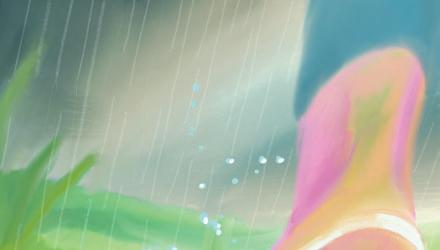
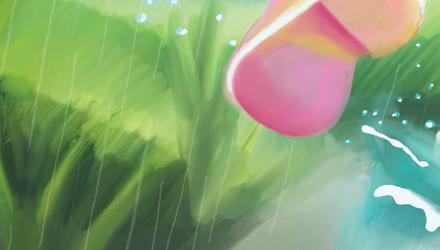



By Amira abd al Rahman - Contributor
The world is big, loud, and too often very fast-paced. In turn, people often find their wonder in the majestic, in the incomprehensibly large.
For me, so much wonder is found in the miniscule, in the imperceptibly small. I find my awe for existence in the things one needs to take a moment to see: the small but mighty, the gorgeous and ephemeral, the gentle blossom which survived the mower.
My photos seek to capture these fleeting elements through the angle which best respects them. I lay in the dirt, stand ankle deep in the mud, and then the picture remains as it was taken, in its pure and unadulterated beauty.

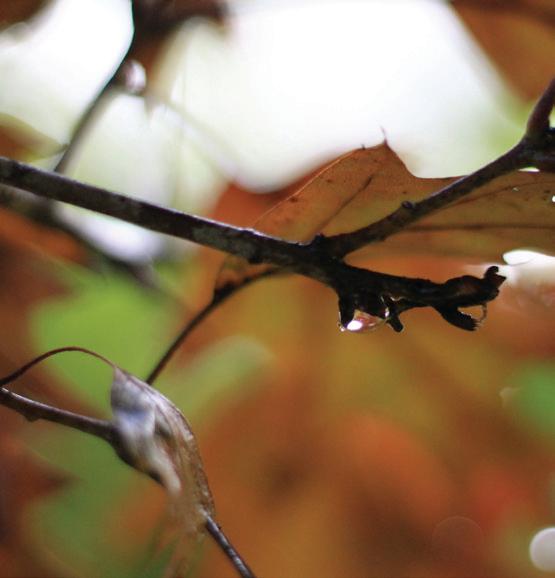


Abby Epstein, Arts & Culture Editor » thecampus.artsculture@gmail.com


By Rachel Matthews - Contributor
This past Saturday, the Bishop’s drama department (BUDD) hosted a postmortem event to commemorate the closing of the New Plays Festival and to foster discussion around its success and what can be improved for future iterations. Headed by the BUDD student representatives, Shannon Gaskarth and Malcolm Armstrong, as well as the New Plays Student Coordinators, Emmett Tinning and Ashlyn Sheehan, the event focused on the students who participated in the festival and encouraged an open dialogue where they could share their experiences. And it is the students who are at the centre of the New Plays Festival, considering that it is entirely student-written, student-directed, student-acted, student-stage-managed and student-coordinated.
EDITOR-IN-CHIEF
Irma Susset thecampus.editor@gmail.com
SENIOR COPY EDITOR
Olivia Norby thecampus.copyeditor@gmail.com
JUNIOR COPY EDITOR
Eryn Costello
For Shannon Gaskarth, allowing and encouraging student feedback was of the utmost importance. She stated, “This year, one of my main values is creating opportunities for students to offer feedback that will be taken into consideration when preparing future student-led initiatives.” With the success of this New Plays Festival, it was important for both the BUDD Representatives to consider what factors contributed to that success so that it can be carried forth to the Theatre Activ festival, which is set to take the stage during the final week of January 2025.
For Shannon and Malcolm, it was equally important to ensure that any barriers to student involvement and success were addressed and resolved during the post-mortem. Indeed, Shannon explained that “the post-mortem opened a deeper understanding of how we and
LAYOUT EDITOR
Melanie Toppa thecampus.layout@gmail.com
ASSOCIATE EDITOR
PHOTOGRAPHER
our department can make these learning opportunities more accessible for students.” Whereas there are prerequisites and other requirements in place for involvement with the Drama Department’s full-length productions, there are no such restrictions on either New Plays or Theatre Activ, and both Shannon and Malcolm are intent on ensuring that any student who wants to be involved has the opportunity to be.
Since its return after the pandemic, theatre at Bishop’s University and beyond has seen a steady increase in attendance. Indeed, this past New Plays boasts the first sold out show since the return to inperson theatre, a stark contrast to the first festival after the pandemic, which only fellow cast members and faculty were permitted to attend as audience members. Across the four-night run of the festival,
NEWS EDITOR
Jillian French thecampus.news@gmail.com
OPINIONS EDITOR
over 250 people attended and 98 made an appearance on the closing night to sell out the house. The previous Theatre Activ Festival attracted an audience of just over 150 people across four nights, so the success of the latest iteration of New Plays seems like a sign that live theatre on campus will continue to grow until it is more triumphant than ever.

ECONOMICS AND BUSINESS EDITOR
thecampus.businesseditor@gmail.com
STAFF WRITERS thecampus.juniorcopyeditor@gmail.com
DIRECTOR OF FINANCE
Kai Luginbuhl thecampus.business@gmail.com
Kate Vandermeulen
Emily Crunican thecampus.photographers@gmail.com
GRAPHICS EDITOR
Damita Melchi & Payton Langevin
Angus Whyte thecampus.associateeditor@gmail.com graphicseditor.thecampus@gmail.com
DIRECTOR OF MARKETING & COMMUNICATIONS
Halle Brindley
thecampus.opinions@gmail.com
FEATURES EDITOR
Katlyn Stoneburner
thecampus.features@gmail.com
SPORTS EDITOR
Owen Kitzan
thecampus.sports@gmail.com
ARTS AND CULTURE EDITOR
Abby Epstein
thecampus.artsculture@gmail.com
Christine Lépine & Lauren Root
THIS ISSUE’S CONTRIBUTORS:
Julie Anne Vollant
Ilona Plat
Joseph Aubert @thebishopscampus Instagram
Chelsea Sheridan
Leighton Geraghty
Dylan Monico
Virginia Pacheco
Grace Johnston
Rachel Matthews
Noah Bishops
Britney Ellis Rahman
Megane Masson
Olivia Woods
Joseph Aubert, Economics & Business Editor » thecampus.businesseditor@gmail.com
outcome will far exceed any obstacles they’ve faced. In a lighthearted moment, she expressed her excitement about the communal kitchen,
noting that she’ll no longer be the only one bringing traditional food and will finally have some left over for herself.
Among other things, the construction of Kwigw8mna represents the Indigenous community’s reclamation of ancestral land that was taken from them long ago. The entire process will be documented for everyone to witness. The purpose of the Kwigw8mna documentary is to chronicle both the hardships and joyful moments experienced during the construction of this home away from home and to illustrate the profound impact it will have on Bishop’s Indigenous community. The documentary will follow several of the individuals involved in the project, capturing moments from the construction site to behind-the-scenes efforts.
“There are so many people involved
that we won’t be able to feature them all, but they are all making a huge difference in this process,” Shawna said, expressing her gratitude to the many contributors. The main takeaway that Shawna and the ISSC team hope viewers will grasp is the importance of listening and communication. “Hard work and change takes time,” she noted, adding that the process, while challenging, is a necessary step that must be faced with open-mindedness and determination.
The documentary will also emphasise the importance of building genuine relationships with Indigenous peoples—not merely acknowledging past wrongdoings, but actively working to repair them. It will serve as an educational tool, shedding light on the long and ongoing journey toward rebuilding and recovery. Although Chatterton-Jerome is unsure of the exact release date, she estimates the documentary will be published around May 2025, shortly after the completion of the Kwigw8mna House.
The Kwigw8mna Centre aims at
having a profound impact on Bishop’s Indigenous community, helping students reconnect with their roots and providing a safe space where they truly belong. Students and community members will be able to connect with others from their nations who share similar interests and experiences. The concept of a “home away from home” is central to the building, offering students from distant Indigenous communities a place to ground themselves, and even providing accommodation for family members during short stays.
Shawna Chatterton-Jerome also expressed hope that Kwigw8mna will encourage more Indigenous students to attend Bishop’s University, noting that a few, if any, institutions have undertaken such a project.
This initiative represents a significant step forward in making higher education more accessible to Indigenous peoples. The construction of Kwigw8mna highlights the importance of Indigenous cultures, languages and
histories, reinforcing the need for spaces that celebrate and preserve these vital elements of identity.
The reconciliation of the Indigenous community and culture at Bishop’s will be honoured through both the documentary and the House. For allies, there are numerous ways to actively participate in Truth and Reconciliation efforts. Among them, Bishop’s offers a course on the Abenaki language and culture, taught by Philippe Charland, Ph.D.
The Abenaki language is severely endangered, and where there is language, there is culture. The complete loss of the Abenaki language would denote a devastating loss of the Abenaki culture, a tragedy for all. The eradication of languages has historically been a tool of oppression, but learning and preserving these languages is a powerful act of resistance. Including a land acknowledgment in Abenaki at the end of emails is a thoughtful gesture, but actually learning this intricate language is a far more meaningful way to contribute.
